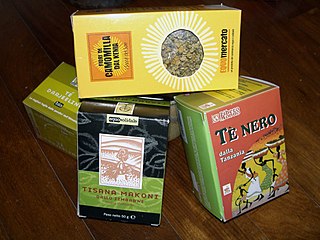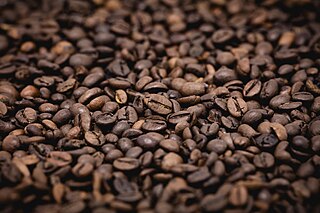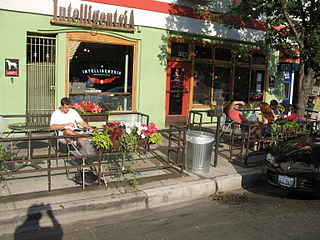Related Research Articles

Fair trade is a term for an arrangement designed to help producers in developing countries achieve sustainable and equitable trade relationships. The fair trade movement combines the payment of higher prices to exporters with improved social and environmental standards. The movement focuses in particular on commodities, or products that are typically exported from developing countries to developed countries but is also used in domestic markets, most notably for handicrafts, coffee, cocoa, wine, sugar, fruit, flowers and gold.

Coffee is a beverage brewed from roasted coffee beans. Darkly colored, bitter, and slightly acidic, coffee has a stimulating effect on humans, primarily due to its caffeine content. It has the highest sales in the world market for hot drinks.

Kopi luwak, also known as civet coffee, is a coffee that consists of partially digested coffee cherries, which have been eaten and defecated by the Asian palm civet. The cherries are fermented as they pass through a civet's intestines, and after being defecated with other fecal matter, they are collected. Asian palm civets are increasingly caught in the wild and traded for this purpose.

Coffee production is the industrial process of converting the raw fruit of the coffee plant into the finished coffee. The coffee cherry has the fruit or pulp removed leaving the seed or bean which is then dried. While all green coffee is processed, the method that is used varies and can have a significant effect on the flavor of roasted and brewed coffee. Coffee production is a major source of income for 12.5 million households, most in developing countries.

Roasting coffee transforms the chemical and physical properties of green coffee beans into roasted coffee products. The roasting process is what produces the characteristic flavor of coffee by causing the green coffee beans to change in taste. Unroasted beans contain similar if not higher levels of acids, protein, sugars, and caffeine as those that have been roasted, but lack the taste of roasted coffee beans due to the Maillard and other chemical reactions that occur during roasting.

Maraba coffee is grown in the Maraba area of southern Rwanda. Maraba's coffee plants are the Bourbon variety of the Coffea arabica species and are grown on fertile volcanic soils on high-altitude hills. The fruit is handpicked, mostly during the rainy season between March and May, and brought to a washing station in Maraba, where the coffee beans are extracted and dried. At several stages, the beans are sorted according to quality. The farmers receive credits based on the amount and quality of the beans they provide.

Coffee is a popular beverage and an important commodity. Tens of millions of small producers in developing countries make their living growing coffee. Over 2.25 billion cups of coffee are consumed in the world daily. Over 90 percent of coffee production takes place in developing countries — mainly South America — while consumption happens primarily in industrialized economies. There are 25 million small producers who rely on coffee for a living worldwide. In Brazil, where almost a third of the world's coffee is produced, over five million people are employed in the cultivation and harvesting of over three billion coffee plants; it is a more labor-intensive culture than alternative cultures of the same regions, such as sugar cane or cattle, as its cultivation is not automated, requiring frequent human attention.

Intelligentsia Coffee is an American coffee roasting company and retailer based in Chicago, Illinois. Founded in 1995 by Doug Zell and Emily Mange, Intelligentsia is considered a major representative of third wave coffee. In 2015, Peet's Coffee & Tea acquired a majority stake in the company.

UTZ, formerly called UTZ Certified, is a program and a label for sustainable farming. The organization was founded as a non-profit in the Netherlands in 2002. The UTZ label is featured on more than 10,000 product packages in over 116 countries. In 2014, UTZ was reported to be the largest program for sustainable farming of coffee and cocoa in the world. The UTZ program addresses agricultural practices, social and living conditions, farm management, and the environment. In January 2018, UTZ officially merged with the Rainforest Alliance in response to the increasing challenges of deforestation, climate change, systemic poverty, and social inequity.

Organic coffee is coffee produced without the aid of artificial chemical substances, such as certain additives or some pesticides and herbicides.

Coffee production in Colombia has a reputation for producing mild, well-balanced coffee beans. Colombia's average annual coffee production of 11.5 million bags is the third total highest in the world, after Brazil and Vietnam, though highest in terms of the arabica bean. The beans are exported to United States, Germany, France, Japan, and Italy. Most coffee is grown in the Colombian coffee growing axis region, while other regions focus on quality instead of volumes, such as Sierra Nevada de Santa Marta. In 2007, the European Union granted Colombian coffee a protected designation of origin status. In 2011, UNESCO declared the "Coffee Cultural Landscape" of Colombia, a World Heritage site.

Coffee production in India is dominated in the hill tracts of South Indian states, with Karnataka accounting for 71%, followed by Kerala with 21% and Tamil Nadu. Indian coffee is said to be the finest coffee grown in the shade rather than direct sunlight anywhere in the world. There are about 250,000 coffee growers in the country; 98% of them are small growers. As of 2009, Indian coffee made up just 4.5% of the global production, being the 7th largest producer of coffee. Almost 80% of Indian coffee is exported; 70% is bound for Germany, Russia, Spain, Belgium, Libya, Poland, Jordan, Malaysia, U.S.A, Slovenia and Austria. Italy accounts for 20.37% of the exports. Most of the export is shipped through the Suez Canal.

Juan Valdez is a fictional character who has appeared in advertisements for the National Federation of Coffee Growers of Colombia since 1958, representing a Colombian coffee farmer. The advertisements were designed by the Doyle Dane Bernbach ad agency, with the goal of distinguishing 100%-Colombian coffee from coffee blended with beans from other countries. He typically appears with his donkey Conchita, carrying sacks of harvested coffee beans. He has become an icon for Colombia as well as coffee in general, and Juan Valdez's iconic appearance is frequently mimicked or parodied in television and other media.

Coffee production in El Salvador has fueled the Salvadoran economy and shaped its history for more than a century. Rapidly growing in the 19th century, coffee in El Salvador has traditionally provided more than 50% of the country's export revenues, reaching a peak in 1980 with a revenue of more than $615 million. With the political and economic turmoil resulting from a civil war in the 1980s, the coffee industry has struggled to recover entirely, and by 1985 earned around $403 million from coffee. Brazil has been buying to sell the goods of El Salvador.
Third-wave coffee is a movement in coffee marketing emphasizing high quality. Beans are typically sourced from individual farms and are roasted more lightly to bring out their distinctive flavors. Though the term was coined in 1999, the approach originated in the 1970s, with roasters such as the Coffee Connection.

Coffee cherry tea is an herbal tea made from the dried skins and/or pulp of the fruit of the coffee plant that remain after the coffee beans have been collected from within. It is also known as cascara, from the Spanish cáscara, meaning "husk". It is similar to a traditional beverage in Yemen and Ethiopia. Starting about 2005 it was independently developed and promoted for export by Salvadoran coffee farmer Aida Batlle. The dried whole fruits are also eaten like raisins.

Coffee production in Tanzania is a significant aspect of its economy as it is Tanzania's largest export crop. Tanzanian coffee production averages between 30,000 and 40,000 metric tons annually of which approximately 70% is Arabica and 30% is Robusta.

Coffee has been grown in Cuba since the mid-18th century. Boosted by French farmers fleeing the revolution in Haiti, coffee farms expanded from the western plains to the nearby mountain ranges. Coffee production in eastern Cuba significantly increased during the 19th and early 20th centuries. At its peak production, Cuba exported more than 20,000 metric tons of coffee beans per year in the mid-1950s. After the Cuban Revolution and the nationalization of the coffee industry, coffee production slowly began to decline until it reached all time lows during the Great Recession. Once a major Cuban export, it now makes up an insignificant portion of Cuban trade. By the 21st century, 92 percent of the country's coffee was grown in area of the Sierra Maestra mountains. All Cuban coffee is exported by Cubaexport, which pays regulated prices to coffee growers and processors.

Counter Culture Coffee is a Durham, North Carolina based coffee roasting company founded in 1995. It has regional training locations in Asheville, NC; Atlanta; Boston; Charleston, SC; Chicago; Durham, NC; Emeryville, CA; New York City; Philadelphia; and Washington, D.C. Counter Culture training centers provide education in the fundamentals of preparing and serving coffee and serve as classrooms and event spaces. Training centers are not only for vendors of Counter Culture Coffee but are also available to anyone interested in coffee production. Training centers also host competition training, food events with guest chefs, and professional workshops.

Agriculture is the main part of Tanzania's economy. As of 2016, Tanzania had over 44 million hectares of arable land with only 33 percent of this amount in cultivation. Almost 70 percent of the rich population live in rural areas, and almost all of them are involved in the farming sector. Land is a vital asset in ensuring food security, and among the nine main food crops in Tanzania are maize, sorghum, millet, rice, wheat, beans, cassava, potatoes, and bananas. The agricultural industry makes a large contribution to the country's foreign exchange earnings, with more than US$1 billion in earnings from cash crop exports.
References
- 1 2 Canavan, Hillary Dixler (2013-11-07). "Chang, Atala, and Redzepi on the Cover of Time". Eater. Retrieved 2023-02-18.
- 1 2 3 4 5 6 7 8 9 10 11 12 13 14 15 16 17 18 19 20 21 22 23 Sanneh, Kelefa (2011-11-14). "Sacred Grounds: Coffee-Farming in El Salvador". ISSN 0028-792X. Archived from the original on 2019-12-21. Retrieved 2019-12-27.
- ↑ "Issue 28: Opera, lions, and coffee". Standart . Retrieved 2023-04-07.
- 1 2 3 "Aida Batlle—Finca Kilimanjaro". PT's Coffee. Archived from the original on 2019-12-27. Retrieved 2019-12-27.
- 1 2 Wald, Leah. "How One Woman Is Defying Gang Violence To Transform El Salvador's Coffee Industry". Forbes. Archived from the original on 2019-12-27. Retrieved 2019-12-27.
- ↑ "Aida Batlle, Finca Kilimanjaro, El Salvador". Wolff Coffee Roasters. Archived from the original on 2019-12-27. Retrieved 2019-12-27.
- 1 2 3 4 5 6 Carpenter, Murray (1 December 2015). "Cascara 'Tea': A Tasty Infusion Made From Coffee Waste". NPR .
- 1 2 Chua-Eoan, Howard (2013-11-18). "Aida Batlle: Riding Coffee's Wave". Time. ISSN 0040-781X . Retrieved 2023-02-18.
- ↑ "Aida Batlle named among top 100 innovators by GOOD Magazine". Global Coffee Report . 2014-04-03. Retrieved 2023-02-18.